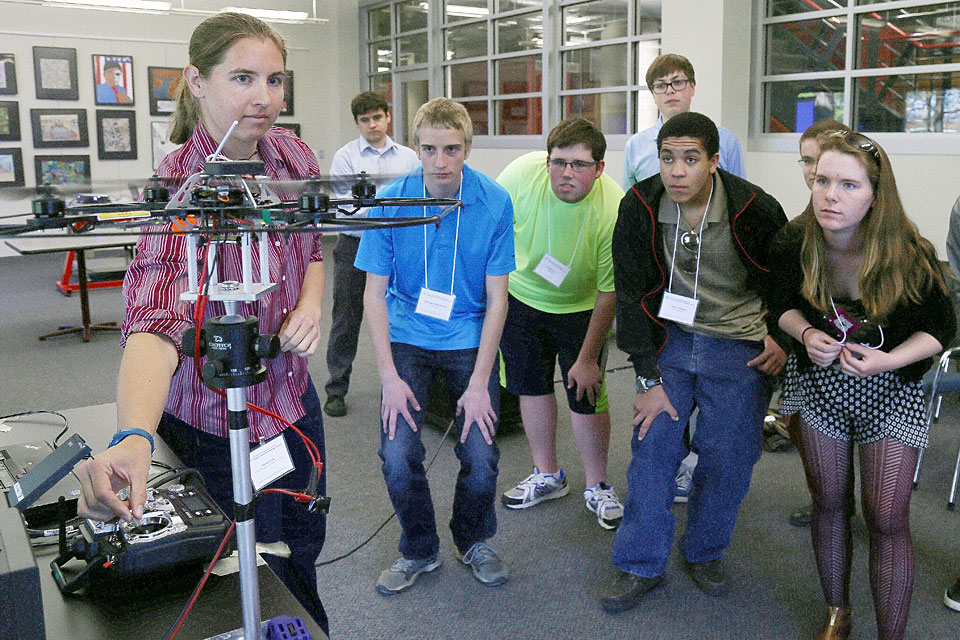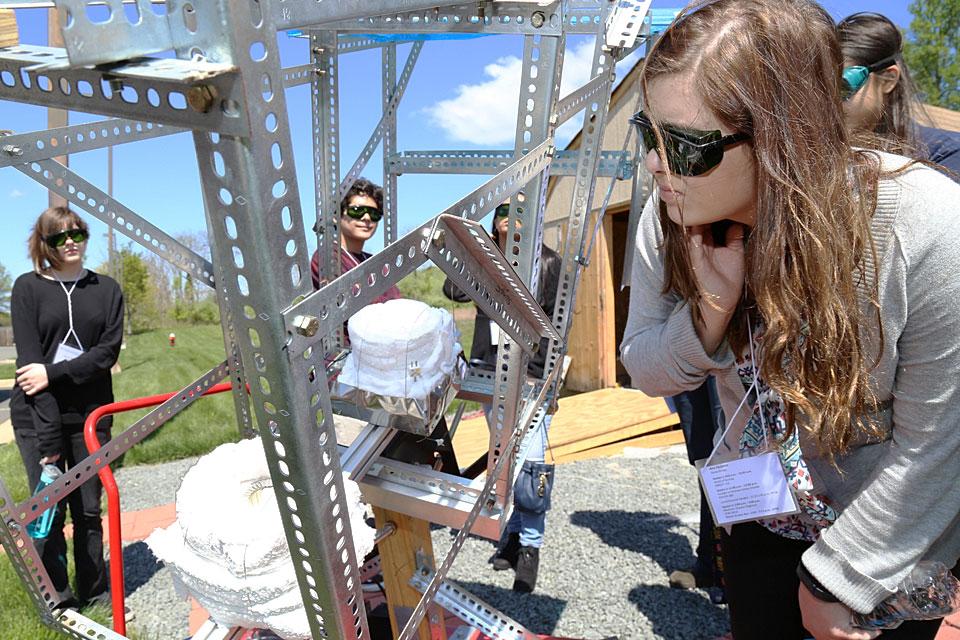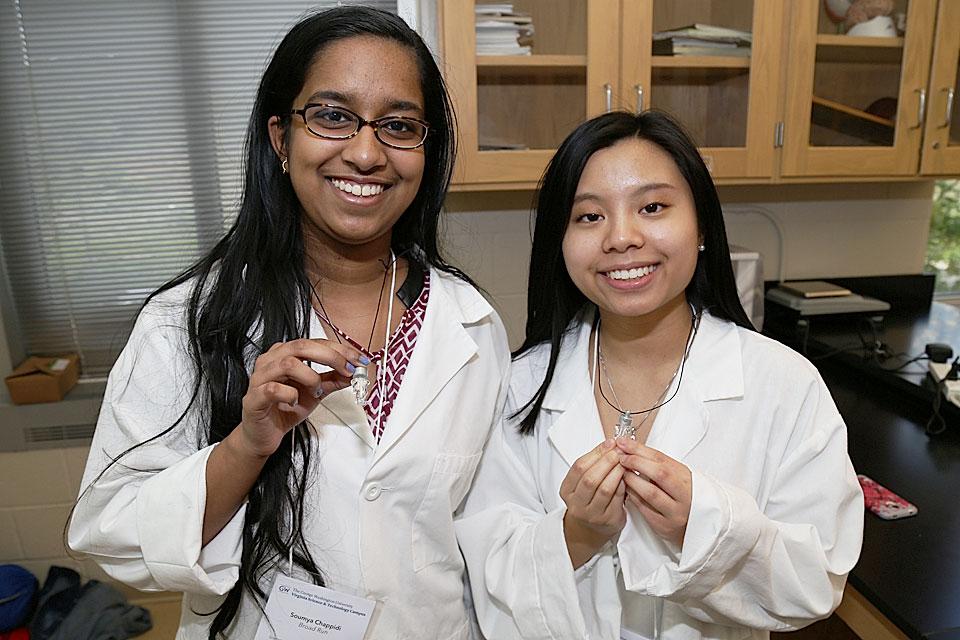Sasha Chowdhury, a Stone Bridge High School junior, would love to intern with Google once she is a college freshman.
“They’re not hiring high schoolers,” she said during a visit to the George Washington University’s Virginia Science and Technology Campus (VSTC).
It may be a few years before Ms. Chowdhury helps to perfect Google’s driverless car, but on Tuesday, the budding scientist had the opportunity to check out a “pretty cool” instrumented vehicle developed by Professor Samer Hamdar and a group of GW researchers in the university’s Traffic and Networks Research Laboratory.
The 2001 Ford Taurus—specially outfitted with a laptop and pricey equipment for sensing and recording small, real-time changes in driver behavior—is helping the researchers’ determine how to predict and prevent collisions.
“What if your vehicle could also talk to the road? What if your car knew that you were going from a two-lane roadway to a one-lane? Your vehicle could provide some sort of feedback to the driver, so that maybe you could change your behavior,” said Ph.D. student Justin Schorr before his captivated audience of high school students took turns piling into the instrumented car.
The demonstration was part of Science, Technology and Engineering (STE) Day, which brought 130 students from 12 Loudoun County Public Schools to the VSTC. The ninth annual event included 11 hands-on workshops hosted by GW faculty and graduate students from departments across the university. Each introduced the high-achieving high schoolers to STEM career fields ranging from nursing and medical technology to digital forensic investigation and climatology.
“At each session I’ve been asking about internship opportunities because it’s definitely something I want to get involved in,” Ms. Chowdhury said. “Everyone was really helpful. They didn’t underestimate our interests.”
The Loudoun County students were among the first ever to make use of the Virginia Campus’ newly constructed teaching labs connected in the collections and conservation resource center (CCRC). The lab spaces will be used for chemistry, biology and physics courses and allow GW’s health sciences programs to expand.
In the new wet labs, Professor Marcia Firmani and faculty from the School of Medicine and Health Sciences hosted a workshop about disease diagnosis in the clinical laboratory. From parasites to urinary tract infections, students observed abnormalities under the microscope and learned how the trained eyes of medical technicians spot diseases.
A few buildings away, GW School of Nursing students gave the high school students a tour through the Skills and Simulation Laboratory, which houses manikin patients and hospital equipment. At the school’s workshop that focused on maintaining healthy lifestyles, students touched a smoker’s lung, listened to a simulated patient’s heartbeat and attempted to do jumping jacks in 20-pound fat suit.
“I never had opportunities like this in high school. I wish I did,” said Tatiana Paulino, a student in the Accelerated Bachelor of Science in Nursing program. “It’s nice to have programs that get us involved in the community.”
After a midday lunch break, students listened to a keynote lecture from Diane M. Stanitski, a program manager in the National Oceanic and Atmospheric Administration (NOAA) Climate Program Office. Dr. Stanitski oversees long-term ocean observation projects that help scientists figure out how to best answer research questions on the Earth’s changing climate.
During her presentation—which many students’ identified as one of their favorite parts of the day—Dr. Stanitski showed off the state-of-the-art instruments that are helping her and other climatologists understand and predict changes in the environment, like a sea ice mass balance buoy that helps to observe and attribute fluctuations in ice thickness.
“Nothing we do across the globe can be done by one person or one group. Projects have to be done in partnership with others. And so, it is critical to be able to work in teams,” she said. “In order to understand our Earth, we need to monitor it together.”
She shared some alarming data with the high school students: Melting ice, changing tides and droughts caused by a heating planet all could have devastating effects on humans. Finally, Dr. Stanitski challenged the future scientists and engineers in the room.
“We need to come up with alternatives. You need to come up with alternatives,” she said. “We all need to work together to find better ways to conserve and also to use our resources more wisely.”
Uyen My Dao, a senior at Park View High School, said Dr. Stanitski inspired her. She was especially interested to learn that scientists can understand drought stress by observing the lines on tree bark.
“That was really interesting. I didn’t know that until today,” said Ms. Dao, who plans to study civil engineering or architecture in college. “Just seeing how the environment can affect lots of things in this world, it really broadened my mind.”
As she finished up her last workshop outdoors, Ms. Dao also was thankful for the sunny day, a pleasant turnaround from Monday’s chilly weather.
“Guess it’s because Dr. Diane [Stanitski] is in town,” she joked. “She’s saving the planet.”












